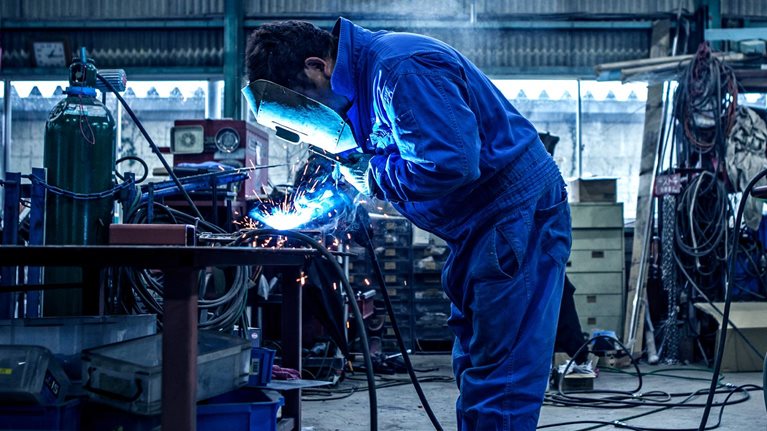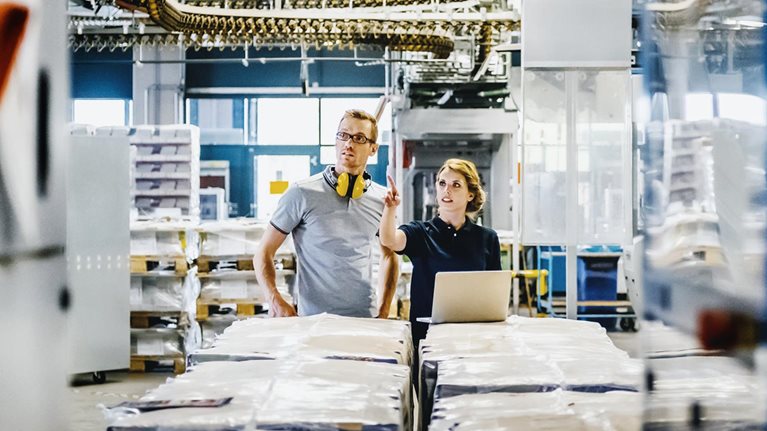The ongoing effects of the COVID-19 crisis. Supply chain disruptions in a period of high demand. An acute energy crisis. These interlocking crises have buffeted the machinery sector, as they have every other part of the economy. However, these crises also present significant opportunities in recovery.
Despite an uncertain global economic outlook,1 machinery companies did surprisingly well throughout 2021. According to our benchmark, machinery companies have come out of the COVID-19 crisis stronger than before: 50 percent of the companies in our sample saw higher revenue in 2021 compared to 2019, 60 percent saw higher EBIT margins, and 35 percent improved on both dimensions.2 The companies that outperformed their peers on profitability after the peak of the COVID-19 crisis in 2020 did so by increasing efficiency, optimizing pricing, and prioritizing high-margin products.
However, the news is not entirely positive. Thirty percent of companies in our benchmark group have not increased their revenue or margins, which suggests that they have not recovered from the initial dent in performance from the COVID-19 crisis. At the same time, escalating costs, supply chain disruptions, and the critical transition toward lowering emissions and operating more sustainably—particularly in the automotive sector—may complicate machinery companies’ ongoing quest for growth.3These structural challenges may compound regional complications, such as projected increases in labor costs.
These challenges require expansive responses. European machinery leaders should manage their supply chains to control their inventory levels and embrace sustainability. Both tasks are broad and therefore easier said than done, but the rewards are outsize.
Multilayered challenges and uneven performance
Our updated benchmark highlighted five characteristics of European machinery companies:
- European machinery companies’ performance lags behind that of their North American counterparts.
- Regions within Europe perform differently.
- Some companies rely heavily on certain customers, particularly from the automotive sector.
- European machinery companies operate in a context of escalating labor and material costs.
- Supply chain challenges are leading to rising inventory levels.
These findings reflect the sector’s structural challenges amid an ongoing sustainability transition.
Lagging performance compared to North American peers
European machinery companies are on a separate path from their North American peers. While revenue growth followed a similar path for European and North American companies from 2016 to 2021, European companies’ profitability has not kept up with that of their North American peers (Exhibit 1).

A fundamental challenge for European companies is how to achieve margins comparable to those of their North American peers. Our analysis shows that North American companies outperformed their European peers on EBIT margins from 2016 to 2021. North American firms’ margins shrank by 0.9 percentage points from 2019 to 2020, while European companies’ margins dropped by 1.9 percentage points.
Several factors contribute to this performance gap. First, North American players tend to operate with a less complex product portfolio. This creates lower complexity costs, especially in the face of supply chain disruptions.4 Second, North American machinery companies adjusted prices to reflect the increased cost of supplies earlier than their European counterparts did. Finally, North American companies derive a higher share of their revenues from services, which yields higher overall margins.
Regional differences within Europe
Machinery companies’ performance within Europe also differs across regions. For instance, Nordic companies have grown their profitability and resilience,5 achieving outcomes that are similar to those of their North American peers.
However, the experiences of machinery companies in Germany have exemplified the challenges in Europe as a whole. German-based companies had a margin drop of 3.1 percentage points from 2019 to 2020, giving them the lowest margins in Europe.
Unlike their peers in the rest of Europe, German companies have not yet been able to offset their higher costs with higher productivity, which is defined as revenue per full-time equivalent (Exhibit 2).

While about a third of German players were able to improve their margins by increasing productivity and reducing material cost share, 45 percent of non-German companies in our benchmark sample were able to improve on both dimensions.
Reliance on sectors affected by sustainability transformations, particularly the automotive sector
Our benchmark shows that the companies whose profitability and margins have suffered the most are the ones that provide equipment for downstream manufacturing, particularly in industries that are the most affected by sustainability transformations.
The most relevant example is European machinery companies’ relationship to the automotive sector. The automotive industry’s work toward more sustainable operations and offerings—such as electric vehicles (EVs)—has drawn a response from European machinery companies. Machinery companies have lowered their R&D ratios (the share of revenue that is spent on R&D) in 2021 to 4.0 percent (down from 4.4 percent in 2020), the first reduction in seven years.
Now that the way forward within the EV space is more tangible, machinery companies in the benchmark sample that have major exposure to the automotive sector are investing, with capital expenditures rebounding after a drop in 2020. The capital expenditure ratios of European machinery companies with exposure to the automotive industry were 1.5 times higher compared to those of companies with no automotive sector exposure.
The energy sector also faces a transition to help it meet sustainability goals, so machinery companies with heavy exposure to the industry will likely encounter similar challenges. Specifically, we expect demand for heavy machinery, such as drilling equipment, to decline as the energy sector moves toward renewables.
Escalating costs
For European machinery companies, increases in the cost of labor should be a built-in expectation. In the past, we have seen an increase in personnel cost of 3.5 to 4.0 percent per year.6 If personnel cost continues to rise by 5.0 percent per year, profitability for the average European machinery company will decline by 1.4 percentage points if nothing else changes. Significantly, companies with a labor-to-material cost ratio of more than 40 percent—which describes one in three European companies in our benchmark—would lose an average of 1.7 percentage points in margin if they do not have an effective response.
Projected cost increases should be especially relevant for German machinery companies: two out of three German machinery companies in our benchmark have lower margins than they did in the 2016–19 period because they were constrained in their ability to contain overall costs. By contrast, two out of three non-German European machinery companies have improved their margins since 2020.
Supply chain challenges leading to rising inventory levels
The effects of unpredictable supply chains are undeniable. Our scenario analysis suggests that two weeks of production losses due to a lack of key inputs could create a 1.7-percentage-point loss for the average European machinery company.
Supply chain disruptions hit the machinery sector twice. Disruptions quickly create production problems because many companies have optimized their supply chains for the pre-COVID-19 context. This means strong relationships with relatively few suppliers and sourcing from around the world for the best technologies and prices. At the same time, customer demand has become more volatile. Customers—who face supply chain disruptions of their own—are ordering more than expected to ensure a minimum supply of inputs. Customers may also respond to disruptions of their own by canceling orders on short notice.
Indeed, supply chain issues economically constrained machinery companies across all regions during the benchmarking period. About 50 percent of companies in the sample were not able to grow their revenue in 2021 compared to 2019.
Supply chain issues kept many companies from completing their products. More than 80 percent of the European companies in our benchmark registered increased inventory levels in 2021 compared to average levels in 2016 to 2020. The inventory ratio for European machinery companies in our benchmark increased by 3.4 percentage points to 20.6 percent, compared to average inventory ratios in 2016 to 2020. Days inventory outstanding, a measure of how quickly inventory is converted into revenue, also increased by ten to 15 days. This is the largest change in inventories in more than five years.
Inventory challenges are associated with lower revenue improvements among companies in our benchmark sample. Of the companies that did not increase their revenues, more than 55 percent registered their highest shares of inventory to revenue since 2016. Among this group, about two-thirds have high levels of exposure to the automotive sector.
Similarly, the net working capital ratio across the European region declined more than one percentage point from 2019 to 2021. This suggests that assets have not been able to outpace liabilities.
Combining short- and long-term moves
Decision makers at machinery companies can examine the strategic implications of escalating costs, snarled supply chains, and the transition toward more sustainable ways of operating. Managing their supply chains with an eye toward inventory management and operating more sustainably can have outsize effects on overall performance.
Manage supply chains to improve inventory levels
High inventory levels are a sign of larger challenges. A central culprit since 2020 has been inconsistent supply chains. Critical best practices include the overhauling of supply chains, the incorporation of new suppliers, localization, second sources, analytics, and end-to-end monitoring.7
One way to build more flexibility into supply chains is to reduce the variability of parts required to manufacture products. Delaying product customization in the manufacturing and assembly process can also help. This makes modular supply chains more relevant to supply chain resilience.
Decision makers at European machinery companies could also collaborate more closely with customers to share the costs of rising materials. Done right, this could reinforce existing relationships and protect margins at the same time.
Embrace sustainability
Rather than deal with disruptions from sustainability, European machinery companies have an opportunity to reframe it as an opportunity for themselves and for their customers. For instance, sourcing for raw materials such as steel can be a significant step toward decarbonizing operations and helping to lower customers’ Scope 3 emissions (emissions from activities and assets not controlled by an organization).8 European machinery companies that accomplish this task especially soon—or especially well—may also be able to achieve price premiums.
European machinery companies could also use sustainability as part of their value proposition. Offerings that support sustainable industries—such as reactors for carbon capturing, compressors for heat pumps, or machines for sustainable packaging—may be significant opportunities for growth.9
In the face of structural, global challenges as well as industry-specific ones, a big-picture response centered on managing supply chains, inventory levels, and sustainability can steady the European machinery industry. Done right, the industry can continue to recover from the initial COVID-19 crisis, navigate volatile markets, and achieve growth and new opportunities.


